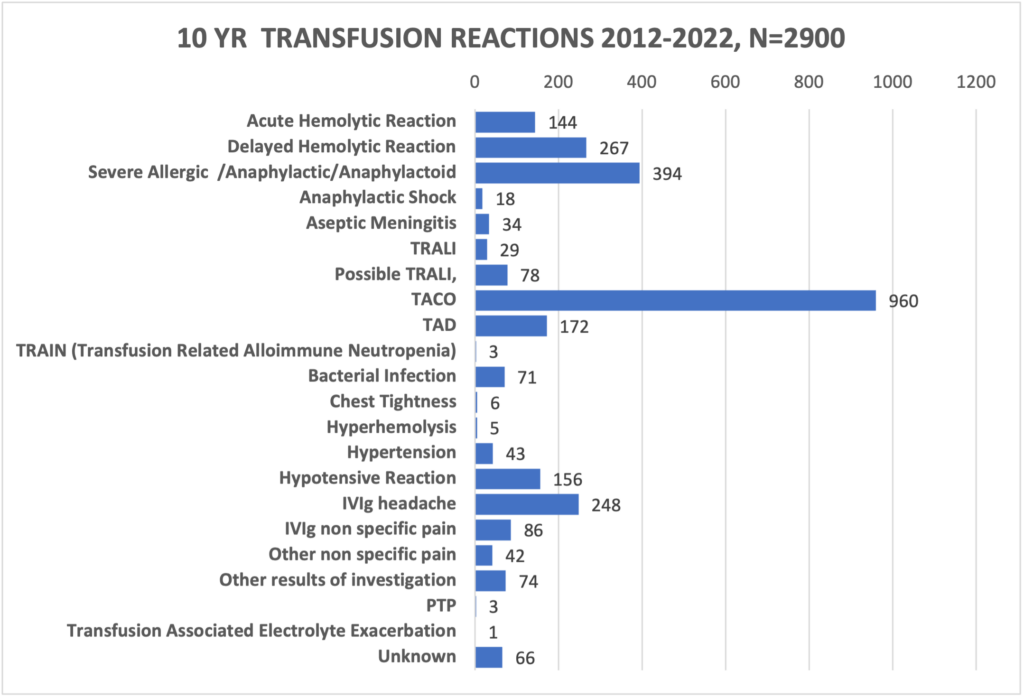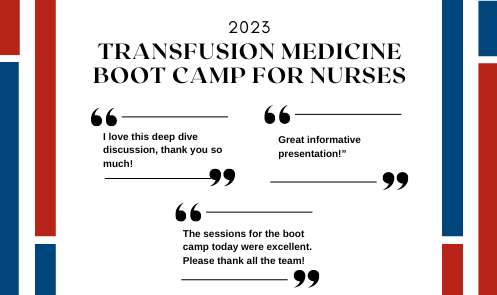December 2023

In This Issue
- Massive Hemorrhage Protocol (MHP) Quality Metrics Portal/Dashboard
- A TTISS Update 2023
- Featured Resources
- Transfusion Medicine Bootcamp for Nurses
- Upcoming Events
- U of T Rounds
Massive Hemorrhage Protocol (MHP) Quality Metrics Portal/Dashboard
Troy Thompson, ORBCoN Program Manager
WHAT?
ORBCoN is pleased to announce the launch of a MHP Quality Metrics Portal for reporting of hospital MHP quality metrics. In 2019, Ontario’s first recommendations for massive hemorrhage protocol was published (Callum et al. CMAJO) which included a statement recommending 8 quality metrics be tracked on all protocol activations and data reviewed quarterly at the hospital level. Table 1 shows the 8 recommended quality metrics. (Q5 was subsequently split into two different quality metrics). This dashboard has been validated in 15 hospitals across Ontario who entered data on MHPs from 2019 to present.
This portal/dashboard will provide hospitals with an efficient way to capture quality metrics data as well as provide a convenient auto-generated report for review at hospital transfusion committees, quality committees and/or Medical Advisory Committees

WHY?
The reporting of quality metrics promotes improvement and increases transparency within the healthcare system. Standardized quality metrics have been developed for the Provincial Massive Hemorrhage Protocol to help assess and improve specific activities over time at individual hospitals. Quarterly provincial reports will allow for peer benchmarking. A “dashboard” has been developed and reports can be generated for your hospitals use. This ‘dashboard’ is interactive, you can select specific criteria to view your site specific data summarized (see example below).

WHO?
Each Ontario hospital will need to determine where the data for the metrics is housed within their facility and who will be responsible for gathering and entering the data. It may be useful to discuss this with your Transfusion Committee and/or your Medical Advisory Committee. Not all data can be accessed or captured from the Transfusion Medicine Laboratory Information System (LIS) and may require access to other sources of data and/or chart review.

HOW?
To begin using the portal please contact the Central ORBCoN office to have you set up and provide you guides to aid in the data entry process. It is recommended to have one dedicated person at your facility to enter the quality metrics data. For any additional information, please contact the Central ORBCoN office at Alison.wendt@sunnybrook.ca.
A TTISS Update 2023
Melanie St John and Joanne Nixon Michael G. DeGroote Centre for Transfusion Research, Department of Medicine, McMaster University, Hamilton, Ontario, Canada (MCTR)
The Transfusion Transmitted Injuries Surveillance System (TTISS) is a national surveillance and monitoring system for the reporting of adverse reactions to blood products (blood components and plasma derivatives) and run by the Public Health Agency of Canada (PHAC). TTISS Ontario (ON) is at McMaster University Michael G. DeGroote Center for Transfusion Research (MCTR).
The successful TTISS-ON annual “hybrid” meeting, held November 17th 2023, had 40 “in-person” and 120 “virtual” attendees and provided positive feedback.
The “Guide for Reporting Transfusion Reactions in Ontario” has been updated and encourages the use of the quick and easy “interactive” guide located on the TTISS-ON website.
The Education Committee has been working on updating the brochure “What to Expect: At Home After a Transfusion” and is currently available on the website.
The TTISS REDCap Database is being redesigned to make it both more user friendly and to add specifics on the type of reaction being reported. One important addition is adding the Canadian Blood Services TRALI form, allowing users to enter all of the required data into one system.
A Ten-Year Report will be published in 2024 based on data from 2013 to 2022. There were over 10,000 reactions reported with approximately 80% being minor reactions. Below is a sneak preview of 2,900 major reactions.

Please visit our website at https://ttiss.mcmaster.ca for these resources. We thank you all for your passion and commitment to the program and for that we now capture 100% of the transfusion activity in Ontario, representing all 159 hospitals.

Featured Resources
Transfusion Medicine Bootcamp for Nurses

Upcoming Events
U of T Rounds

January 25, 2023 @12pm-1pm
Subscribe to U of T Transfusion Medicine Rounds mailing list to get registration details